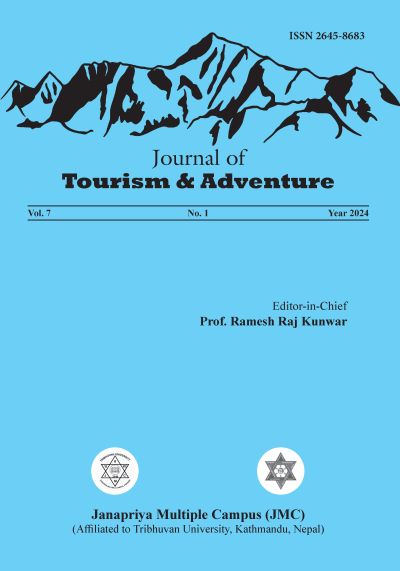Trend Analysis of Tourist-arrivals in Nepal Using Auto- Regressive Integrated Moving Average (ARIMA) Model
DOI:
https://doi.org/10.3126/jota.v7i1.69542Keywords:
Tourists-arrivals, trend analysis, auto regressive integrated moving average model, forecasting, NepalAbstract
Nepal, a diverse and geographically varied landlocked country with a rich tapestry of cultures, and natural heritages, boasts iconic attractions such as Mt. Everest as the world’s highest peak, Lumbini as the birthplace of Lord Buddha, Pashupatinath Temple as one of the world’s most celebrated pilgrimages for the Hindus, Chitwan National Park, home to the one-horned rhino enlisted by United Nations Educational, Scientific and Cultural Organization world’s natural treasure, etc. Attracting tourists from all corners of the globe, Nepal’s unique blend of landscapes and cultural heritage has made this country a prominent destination. This research delves into a comprehensive trend analysis of tourist arrivals in Nepal from 1964 to 2023, employing the Auto Regressive Integrated Moving Average (ARIMA) model based on the secondary data employed from the Ministry of Finance, Government of Nepal. The model provides insights into past trends and forecasts future tourist arrivals, evidenced by the rigorous test using the Root Mean Square Error. The analysis employed several ARIMA models, including ARIMA (2, 1, 3), ARIMA (2, 1, 2), ARIMA (3, 1, 3), and ARIMA (3, 1, 2), with model performance assessed using criteria such as Akaike Information Criterion (AIC) and Mean Absolute Error (MAE). Findings indicate that the ARIMA (2 1, 3) model provides the most accurate forecasts compared to the other models tested. This finding has significant implications for Nepal’s tourism industry. The results underscore the importance of adopting flexible and strategic planning approaches to enhance the resilience of Nepal’s tourism sector. The study’s insights are valuable for policymakers, industry stakeholders, and researchers, contributing to the development of targeted strategies that ensure sustainable growth in the face of ongoing volatility.
Downloads
Downloads
Published
How to Cite
Issue
Section
License
Authors retain the copyright of their articles.




